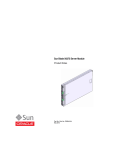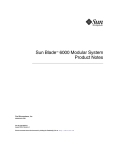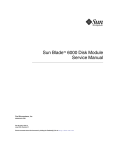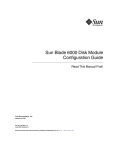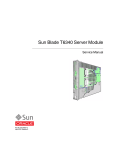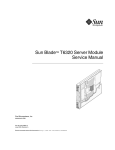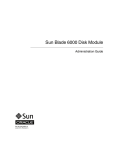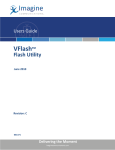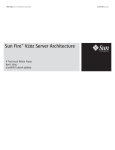Download Sun Blade 6000 Modular System Overview
Transcript
Sun Blade™ 6000 Modular System Overview Sun Microsystems, Inc. www.sun.com Part No. 820-7122-14 November 2009 Submit comments about this document by clicking the Feedback[+] link at: http://docs.sun.com Copyright 2009 Sun Microsystems, Inc., 4150 Network Circle, Santa Clara, California 95054, U.S.A. All rights reserved. Sun Microsystems, Inc. has intellectual property rights relating to technology that is described in this document. In particular, and without limitation, these intellectual property rights may include one or more of the U.S. patents listed at http://www.sun.com/patents and one or more additional patents or pending patent applications in the U.S. and in other countries. This document and the product to which it pertains are distributed under licenses restricting their use, copying, distribution, and decompilation. No part of the product or of this document may be reproduced in any form by any means without prior written authorization of Sun and its licensors, if any. Third-party software, including font technology, is copyrighted and licensed from Sun suppliers. Parts of the product may be derived from Berkeley BSD systems, licensed from the University of California. UNIX is a registered trademark in the U.S. and in other countries, exclusively licensed through X/Open Company, Ltd. Sun, Sun Microsystems, the Sun logo, Java, AnswerBook2, docs.sun.com, Sun Blade, and Solaris are trademarks or registered trademarks of Sun Microsystems, Inc., or its subsidiaries in the U.S. and in other countries. All SPARC trademarks are used under license and are trademarks or registered trademarks of SPARC International, Inc. in the U.S. and in other countries. Products bearing SPARC trademarks are based upon an architecture developed by Sun Microsystems, Inc. Intel® is a trademark or registered trademark of Intel Corporation or its subsidiaries in the United States and other countries. Intel® Xeon® is a trademark or registered trademark of Intel Corporation or its subsidiaries in the United States and other countries. Intel Inside® is a trademark or registered trademark of Intel Corporation or its subsidiaries in the United States and other countries. AMD Opteron is a trademark or registered trademark of Advanced Microdevices, Inc. The OPEN LOOK and Sun™ Graphical User Interface was developed by Sun Microsystems, Inc. for its users and licensees. Sun acknowledges the pioneering efforts of Xerox in researching and developing the concept of visual or graphical user interfaces for the computer industry. Sun holds a non-exclusive license from Xerox to the Xerox Graphical User Interface, which license also covers Sun’s licensees who implement OPEN LOOK GUIs and otherwise comply with Sun’s written license agreements. U.S. Government Rights—Commercial use. Government users are subject to the Sun Microsystems, Inc. standard license agreement and applicable provisions of the FAR and its supplements. DOCUMENTATION IS PROVIDED “AS IS” AND ALL EXPRESS OR IMPLIED CONDITIONS, REPRESENTATIONS AND WARRANTIES, INCLUDING ANY IMPLIEDWARRANTY OF MERCHANTABILITY, FITNESS FOR A PARTICULAR PURPOSE OR NON-INFRINGEMENT, ARE DISCLAIMED, EXCEPT TO THE EXTENT THAT SUCH DISCLAIMERS ARE HELD TO BE LEGALLY INVALID. Copyright 2009 Sun Microsystems, Inc., 4150 Network Circle, Santa Clara, Californie 95054, Etats-Unis. Tous droits réservés. Sun Microsystems, Inc. a les droits de propriété intellectuels relatants à la technologie qui est décrit dans ce document. En particulier, et sans la limitation, ces droits de propriété intellectuels peuvent inclure un ou plus des brevets américains énumérés à http://www.sun.com/patents et un ou les brevets plus supplémentaires ou les applications de brevet en attente dans les Etats-Unis et dans les autres pays. Ce produit ou document est protégé par un copyright et distribué avec des licences qui en restreignent l’utilisation, la copie, la distribution, et la décompilation. Aucune partie de ce produit ou document ne peut être reproduite sous aucune forme, par quelque moyen que ce soit, sans l’autorisation préalable et écrite de Sun et de ses bailleurs de licence, s’il y en a. Le logiciel détenu par des tiers, et qui comprend la technologie relative aux polices de caractères, est protégé par un copyright et licencié par des fournisseurs de Sun. Des parties de ce produit pourront être dérivées des systèmes Berkeley BSD licenciés par l’Université de Californie. UNIX est une marque déposée aux Etats-Unis et dans d’autres pays et licenciée exclusivement par X/Open Company, Ltd. Sun, Sun Microsystems, le logo Sun, Java, AnswerBook2, docs.sun.com, Sun Fire, Sun Blade, et Solaris sont des marques de fabrique ou des marques déposées de Sun Microsystems, Inc. aux Etats-Unis et dans d’autres pays. Toutes les marques SPARC sont utilisées sous licence et sont des marques de fabrique ou des marques déposées de SPARC International, Inc. aux Etats-Unis et dans d’autres pays. Les produits portant les marques SPARC sont basés sur une architecture développée par Sun Microsystems, Inc. AMD Opteron est une marque de fabrique ou une marque deposee de Advanced Microdevices, Inc. L’interface d’utilisation graphique OPEN LOOK et Sun™ a été développée par Sun Microsystems, Inc. pour ses utilisateurs et licenciés. Sun reconnaît les efforts de pionniers de Xerox pour la recherche et le développement du concept des interfaces d’utilisation visuelle ou graphique pour l’industrie de l’informatique. Sun détient une license non exclusive de Xerox sur l’interface d’utilisation graphique Xerox, cette licence couvrant également les licenciées de Sun qui mettent en place l’interface d ’utilisation graphique OPEN LOOK et qui en outre se conforment aux licences écrites de Sun. LA DOCUMENTATION EST FOURNIE “EN L’ÉTAT” ET TOUTES AUTRES CONDITIONS, DECLARATIONS ET GARANTIES EXPRESSES OU TACITES SONT FORMELLEMENT EXCLUES, DANS LA MESURE AUTORISEE PAR LA LOI APPLICABLE, Y COMPRIS NOTAMMENT TOUTE GARANTIE IMPLICITE RELATIVE A LA QUALITE MARCHANDE, A L’APTITUDE A UNE UTILISATION PARTICULIERE OU A L’ABSENCE DE CONTREFAÇON. Please Recycle Contents 1. Introduction 1 Logical Components Blade Modules 1 2 RAID Expansion Modules Fabric Expansion Modules NEMs 4 5 6 PCIe EMs 8 Chassis Monitoring Module and Service Processor 2. Infrastructure Components Chassis 11 11 Power Supplies and Front Fan Modules Rear Fan Modules 3. 9 11 12 Related Documentation 15 15 4. Managing Firmware 17 How Sun Blade 6000 Firmware is Released Getting the Latest Sun Firmware Release 17 18 iii Sun Blade 6000 Chassis Management Module (CMM) Blade Server Support Matrix 18 The Scope and Purpose of Software Updates 19 Chassis and Server Module Firmware Compatibility Updating Chassis and Server Module Firmware Firmware Update Procedures 20 20 Adding a Server Module to the Chassis 20 Chassis and Server Modules running ILOM iv 19 ELOM-to-ILOM Transition 21 ELOM-to-ELOM Upgrades 22 21 Sun Blade X6000 Server Module Operating System Installation Guide • November 2009 CHAPTER 1 Introduction This document provides an overview of the Sun Blade 6000 modular system. This document is divided into the following sections: ■ “Logical Components” on page 1 describes the components that provide the computational functionality of the system. They consist of the blade modules, Network Express Modules (NEMs), and PCIe ExpressModules (PCIe EMs). ■ “Chassis Monitoring Module and Service Processor” on page 9 describes the service processor, which allows administrators to monitor and manage logical components and infrastructure components, even when they are powered off. ■ “Infrastructure Components” on page 11 describes the infrastructure components, which consist of the chassis, the fans, and the power supplies. ■ “Related Documentation” on page 15 describes the Sun Blade 6000 modular system documentation set. ■ “Managing Firmware” on page 17 discusses managing firmware in the chassis and the server modules. Logical Components This section describes the logical components in the Sun Blade 6000 modular system and how they interact with each other. The logical components appear in FIGURE 1-1. 1 FIGURE 1-1 Sun Blade 6000 Modular System Logical Components The logical components include: ■ Blade Modules – See“Blade Modules” on page 2. ■ Network Express Modules (NEMs) –See “NEMs” on page 6 for details. ■ PCIe ExpressModules (PCIe EMs) – See “PCIe EMs” on page 8 for details. Note – The Chassis Management Module (CMM) is described in “Chassis Monitoring Module and Service Processor” on page 9. Blade Modules Blade modules form the backbone of the system; in a sense, the other components exist to support their functionality. The system holds ten blade modules in slots 0 through 9. 2 Sun Blade X6000 Modular System Overview • November 2009 Blade modules come in two categories: server modules and storage modules. Most server modules are complete, autonomous servers, although some of them have no hard drives and must be attached to external storage. Storage modules provide additional storage for the server modules. A single chassis can hold any combination of supported server modules. Each slot operates independently and is not affected by the server modules in adjacent slots. Thus, an x64 module such as a Sun Blade X6250 can be installed next to a SPARC module such as a Sun Blade T6320. Storage modules provide additional storage for server modules. The currentlysupported storage module provides eight disks connected to two SAS expanders. It provides storage to a single server module which must be in an even-numbered slot immediately to its left. The storage module must be used in conjunction with a SAS-compatible Network Expansion Module (NEM). Also, the corresponding server module must have a compatible host bus adaptor (HBA), which is usually provided on a RAID Expansion Module (REM). See “NEMs” on page 6, and “RAID Expansion Modules” on page 4. The following table lists the blade modules: Note – The lists of supported modules in this document are current as of the date this document was published; however new modules will be added as they are developed. For an up-to-date list, see http://www.sun.com/servers/blades/offerings.jsp. TABLE 1 Blade Servers Module CPU Type Documentation Web Site Sun Blade 6000 Disk Module Storage Module http://docs.sun.com/app/docs/prod/blade.6000disk#hic Sun Blade X6048 Storage Module http://docs.sun.com/app/docs/prod/blade.x6048#hic Sun Blade X6220 AMD Operton http://docs.sun.com/app/docs/prod/blade.x6220#hic Sun Blade X6240 AMD Opteron http://docs.sun.com/app/docs/prod/blade.x6240#hic Sun Blade X6250 Intel Xeon http://docs.sun.com/app/docs/prod/blade.x6250#hic Sun Blade X6270 Intel Xeon http://docs.sun.com/app/docs/prod/blade.x6270#hic Sun Blade X6275 Intel Xeon http://docs.sun.com/app/docs/prod/blade.x6275#hic Sun Blade X6440 AMD Opteron http://docs.sun.com/app/docs/prod/blade.x6440#hic Sun Blade X6450 Intel Xeon http://docs.sun.com/app/docs/prod/blade.x6450#hic Introduction 3 TABLE 1 Blade Servers Module CPU Type Documentation Web Site Sun Blade T6300 SPARC http://docs.sun.com/app/docs/prod/blade.t6300#hic Sun Blade T6320 SPARC http://docs.sun.com/app/docs/prod/blade.t6320#hic Sun Blade T6340 SPARC http://docs.sun.com/app/docs/prod/blade.t6340#hic ■ REMs are HBAs that control disks on their parent boards and on companion storage modules. See “RAID Expansion Modules” on page 4. ■ FEMs support 10GbE Ethernet connectivity. They work with the 10GbE capability of many NEMs. For more information, see “Fabric Expansion Modules” on page 5. RAID Expansion Modules REMs provide HBA functionality on some blade servers. They mount to a REM connector on the blade motherboard. The currently-supported REMs include: ■ Sun Blade RAID 5 expansion module – supports single disks, and RAID levels 0, 1, 1E, 10, 5, or 6 with global or dedicated hot spares. ■ Sun Blade RAID 0/1 expansion module – supports single disks, and RAID levels 0, 1, and 1E. FIGURE 1-2 shows a REM being installed on a Sun Blade X6450 server module. 4 Sun Blade X6000 Modular System Overview • November 2009 FIGURE 1-2 Installation of a REM on a Sun Blade X6450 Server Motherboard Fabric Expansion Modules FEMs allow blade servers to use the 10GbE connections provided by certain NEMs. These NEMs and the corresponding FEMs operate as a matched set. For example, a blade must have a Sun Dual 10GbE FEM to use the 10GbE functionality on a Sun Blade 6000 10GbE Multi-Fabric NEM. FEMs are installed on the FEM connector on the blade motherboard. shows a Fabric Expansion Module on a Sun Blade X6450 server module.Installation of a FEM on a Sun Blade X6450 Server Motherboard. Introduction 5 FIGURE 1-3 Installation of a FEM on a Sun Blade X6450 NEMs NEMs offer systemic connectivity to the blades in the chassis. Each NEM connects to all 10 blade slots. The basic NEM provides a 10/100/1000 Ethernet connection for each blade. Other NEMs can provide SAS connectivity to disk blades and 10GbE Ethernet ports, in addition to the 10/100/1000 Ethernet connection for each blade. 6 Sun Blade X6000 Modular System Overview • November 2009 The chassis provides two NEM slots. Adding a second NEM provides a second set of 10/100/1000 Ethernet connections for each blade. For NEMs with SAS connectivity, adding a second NEM provides a redundant connection to SAS disks. Note – If there is no NEM in the chassis, a PCIe EM can be used to provide server blades with Ethernet connectivity. See “PCIe EMs” on page 8 for information on PCIe EMs. Most NEMs are hot swappable or hot pluggable. ■ Hot swappable components can be removed and replaced without shutting down any system component. ■ Hot pluggable components can be removed without shutting down the system; however, administrators must prepare the system first. Usually this requires idling or turning off the component to be hot plugged. The type of connectivity depends on the NEM. Note – Most NEM functions, other than the 10/100/1000 Ethernet port, require a matching REM or FEM mounted on the blade motherboard before the blade server can use that function. See “RAID Expansion Modules” on page 4 or “Fabric Expansion Modules” on page 5 for more information. The supported NEMS include: ■ Basic NEM ■ ■ ■ ■ A single 10/100/1000 Mb Ethernet port for each slot Sun Blade 6000 Multi-Fabric NEM ■ A single 10/100/1000 Mb Ethernet port for each slot ■ SAS connectivity between a server module and an adjacent Sun Blade 6000 disk module Sun Blade 6000 10GbE Multi-Fabric NEM ■ A single 10/100/1000 Mb Ethernet port for each blade slot ■ SAS connectivity between a server module and an adjacent Sun Blade 6000 disk module ■ A single 10GbE port for each of 10 server modules Sun Blade 6000 Virtualized Multi-Fabric 10GbE NEM ■ A single 10/100/1000 Mb Ethernet port for each blade slot ■ SAS connectivity between a server module and an adjacent Sun Blade 6000 disk module ■ Two virtualized 10GbE connections that are shared by the 10 server modules Introduction 7 Note – Check http://www.sun.com/servers/blades/offerings.jsp for the latest list of supported NEMs. PCIe EMs The PCIe EMs are designed to offer independent, dedicated I/O functions configurable on a per server module basis. Each blade slot has two dedicated PCIe EM slots, numbered as follows: TABLE 2 Blade and PCIe EM Slot Numbering Blade Slot PCIe EM Slots 0 0, 1 1 2, 3 2 4, 5 3 6, 7 4 8,9 5 10,11 6 12,13 7 14,15 8 16,17 9 18,19 The PCIe EM format is a standard developed by the PCI-SIG standards organization. The chassis midplane implements PCI-Express connectivity between the PCIe EMs and server modules and assigns two PCIe EMs to each server module. Most PCIe EMs are hot-swappable or hot-pluggable, allowing system administrators to easily replace them. PCIe EMs can be installed in a system without any modification to the connected server module hardware. The Sun Blade 6000 modular system supports industrystandard, hot-swappable PCIe EMs. Check http://www.sun.com/servers/blades/optioncards.jsp for the latest list of supported PCIe EM modules. 8 Sun Blade X6000 Modular System Overview • November 2009 Chassis Monitoring Module and Service Processor The chassis has a service processor module, called a Chassis Management Module (CMM). This service processor (SP) supports the service processor program, called the Integrated Lights-Out Manager (ILOM). The CMM appears in “Logical Components” on page 1. The service processor allows you to manage chassis components and to access the service processors of the individual server modules even when the chassis and/or the server modules are powered off. The ILOM enables you to: ■ Display and configure ILOM network parameters ■ Display and configure server module SP network parameters ■ Connect to server module SP ■ Display the following information about chassis components: ■ Whether the component is present ■ FRU SEEPROM data ■ Status In addition to the CMM which manages the chassis, each server blade has its own service processor that operates independently of the CMM. These can be accessed by entering a command on the CMM. They can also be accessed directly, through their SP IP address or through a dongle connector on the front of the server module. Disk blades do not have a service processor. The CMM provides a limited set of commands for managing them. Introduction 9 10 Sun Blade X6000 Modular System Overview • November 2009 CHAPTER 2 Infrastructure Components The infrastructure components provide physical support, power, and cooling for the system. They include the chassis, two power supplies with integrated fan modules, and the six rear fan modules. ■ “Chassis” on page 11 ■ “Power Supplies and Front Fan Modules” on page 11 Chassis The chassis is the physical enclosure that contains the system components. It is designed for rackmounting and can be mounted into 19-inch EIA-310D cabinets with a depth of 35.4 to 39.4 inches (90.0 to 100.1 cm). The chassis can accommodate corresponding front-to-back, rail-to-rail spacing of 26.77 inches (68.0 cm) to 34.25 inches (87.0 cm). Caution – The chassis requires clear airflow from front to back. There must be no doors on the cabinet or rack, and no other obstructions. Also, all blade slots must be occupied by either a blade or a blank filler panel. Power Supplies and Front Fan Modules The system contains two redundant power supplies, each capable of powering the chassis. Each power supply has an integrated fan module, as shown in FIGURE 2-1. 11 FIGURE 2-1 Power Supply and Front Fan Module Rear Fan Modules The system has six redundant fan modules, in the rear of the system enclosure. FIGURE 2-2 shows the location of the modules and provides a close-up of one of them. 12 Sun Blade X6000 Modular System Overview • November 2009 FIGURE 2-2 Rear Fan Modules Infrastructure Components 13 14 Sun Blade X6000 Modular System Overview • November 2009 CHAPTER 3 Related Documentation Documentation for the Sun Blade 6000 modular system is on the web at: http://docs.sun.com/app/docs/prod/blade.6000mod#hic The documentation for the Sun Blade 6000 modular system is divided by function into the following collections: ■ System Documentation – This collection contains the basic documentation for the system, including installation, service, safety and compliance, and product notes. ■ ILOM Documentation – This collection contains documentation for the chassis’ service processor, called the Chassis Management Module Integrated Lights-Out Manager (CMM ILOM). It also provides documentation for the Integrated LightsOut Manager (ILOM), which is the service processor used by most (but not all) server modules. The individual web site for each server module also provides documentation for that server module’s service processor. ■ Sun Blade 6000 Multi-Fabric Network Express Module, and Sun Blade 10GbE Multi-Fabric Network Express Module – These collections provide documentation for their respective NEMs. 15 16 Sun Blade X6000 Modular System Overview • November 2009 CHAPTER 4 Managing Firmware This section discusses managing firmware in the chassis and the server modules. It includes information about updating firmware and about keeping the firmware in the chassis elements compatible with other chassis elements. ■ “How Sun Blade 6000 Firmware is Released” on page 17 ■ “Getting the Latest Sun Firmware Release” on page 18 ■ “The Scope and Purpose of Software Updates” on page 19 ■ “Chassis and Server Module Firmware Compatibility” on page 19 ■ “Updating Chassis and Server Module Firmware” on page 20 ■ “Firmware Update Procedures” on page 20 How Sun Blade 6000 Firmware is Released The firmware is incorporated into new chassis and blade products at the factory. However, it is updated periodically in packages called either “software updates” or “firmware updates.” All of these updates are released for either a single server module (for example the Sun Blade X6450 server module), or for the Sun Blade 6000 chassis. Note – For server modules, software updates can include software and firmware. However, the chassis has no software, so the chassis software updates contain only firmware. A major release is where the first number changes, for example, from 2.0 to 3.0. A minor release is where the second number changes, for example from 2.0. to 2.1. 17 Getting the Latest Sun Firmware Release All software and firmware for the Sun Blade 6000 and associated server modules can be downloaded from: http://www.sun.com/servers/blades/downloads.jsp#6000 The download page for each product provides a list of major changes from one release to the next. A more detailed list of problems fixed by the download is available in the corresponding product notes and web download page. Sun Blade 6000 Chassis Management Module (CMM) Blade Server Support Matrix The most recently available blade server software release is preferred for use with the Sun Blade 6000 CMM software. Starting with CMM SW Release 3.1.2 this support matrix is available within the CMM SW Release download file list under Optional Files. The software support matrix provides the blade software release versions that are recommended for use with a specific CMM release. To access this page: 1. Navigate to: http://www.sun.com/servers/blades/downloads.jsp#6000 2. Press the Download button under Sun Blade 6000 Modular System Downloads. The Sun Blade 6000 Chassis SW 3.1.2 page opens. From this page you set up an account: 3. Click on the checkbox to select the I agree to the SunBlade X6000 3.1.2 License Agreement. 4. Enter a User Name and Password. As soon as your account is active you can access the Blade Server Support Matrix, located under Optional Files. 18 Sun Blade X6000 Modular System Overview • November 2009 The Scope and Purpose of Software Updates The chassis and server modules each have a corresponding product notes document that lists known issues with the hardware, software (server modules only), firmware, service processor, and documentation. These documents describe the issues and provide workarounds where possible. The product notes document is updated with each major software release and often for minor releases as well. Sun recommends that customers review this document as part of managing firmware. The chassis product notes also include a list of bugs fixed in each release. A list of bugs fixed is included and is also usually a part of the web downloadable software release bundle available at: http://www.sun.com/servers/blades/downloads.jsp#6000 Product notes for the server modules and storage blades can be found at http://docs.sun.com/app/docs/prod/blade.srvr Follow the links on this page to the corresponding server module for the complete set of documentation associated with that server module. Chassis and Server Module Firmware Compatibility Sun tests the following components against other chassis components that are running the latest available firmware and the prior revision. ■ New Server Modules ■ New NEMs ■ Firmware updates for server modules, CMM, and NEMs If any component is using firmware older than the prior version, the intercomponent dependencies will not have been exhaustively tested. While there is no reason to believe there will be any compatibility issue, Sun cannot guarantee this. Caution – Sun strongly recommends that all components in and including the chassis use the latest available firmware or the prior released version of the firmware. Managing Firmware 19 Because of the bug fixes and new features available in software updates, Sun recommends that the latest firmware be installed as soon as is reasonably practical. Updating Chassis and Server Module Firmware Sun Blade 6000 firmware and server module firmware can be upgraded independently. If a NEM firmware update is required, Sun recommends that it is installed before other firmware. Caution – Some firmware upgrade procedures remove a component from service. For example, server module ILOM upgrade procedures might shut down the server to perform BIOS upgrades. NEM and storage module firmware upgrades (or hotswapping) might interrupt I/O connectivity to multiple blades. Firmware Update Procedures See the following sections for information on firmware update procedures. See the corresponding product notes for information about known issues and service dependencies. ■ “Adding a Server Module to the Chassis” on page 20 ■ “Chassis and Server Modules running ILOM” on page 21 ■ “ELOM-to-ILOM Transition” on page 21 ■ “ELOM-to-ELOM Upgrades” on page 22 Adding a Server Module to the Chassis Normally, you can install a server module with newer firmware than existing server modules in the chassis without adversely impacting the other components in the chassis. 20 Sun Blade X6000 Modular System Overview • November 2009 Note – However, to ensure that this is the case, Sun recommends that all components use the latest version of the firmware or the prior release of the firmware. Chassis and Server Modules running ILOM ILOM is Sun’s common service processor firmware. It is the standard for rackmount servers, blade chassis and server modules, regardless of the CPU architecture. The Sun Blade 6000 Chassis and all newer Sun server modules, including SPARC, Intel, and AMD, run ILOM. To update ILOM you must know the name of the firmware update file. This is documented in the platform ILOM Supplement. Apart from the filename the general procedures for updating ILOM firmware are identical from server module to server module and are located in the ILOM Users Guide. See the ILOM documentation collection for the corresponding product for details. ILOM document collections are located here: http://docs.sun.com/app/docs/prod/int.lights.mgr30#hic Note – The T6300 server module is an exception; it uses ALOM. See the T6300 documentation for details. Note – Some server modules were originally shipped with the ELOM (Embedded Lights Out Manager) service processor firmware. See the Elom-to-Ilom Transition section below. ELOM-to-ILOM Transition Some server modules were originally shipped with the ELOM (Embedded Lights Out Manager) service processor firmware, such as the Sun Blade X6250 and Sun Blade X6450 server modules. These can all be updated to ILOM. Sun recommends that all server modules running ELOM be updated to run ILOM. This procedure is documented in the ELOM-to-ILOM Migration User’s Guide, which is included in the corresponding server module documentation collections. Managing Firmware 21 ELOM-to-ELOM Upgrades The procedure for updating all server modules that run ELOM is in the ELOM-toILOM Migration User’s Guide, which is available in the documentation collections for all server modules that run ELOM. This document is located in the Sun Blade 6250 Server Module - ILOM Supplements and ELOM Documentation collection. http://docs.sun.com/app/docs/prod/blade.6000mod#hic 22 Sun Blade X6000 Modular System Overview • November 2009


























